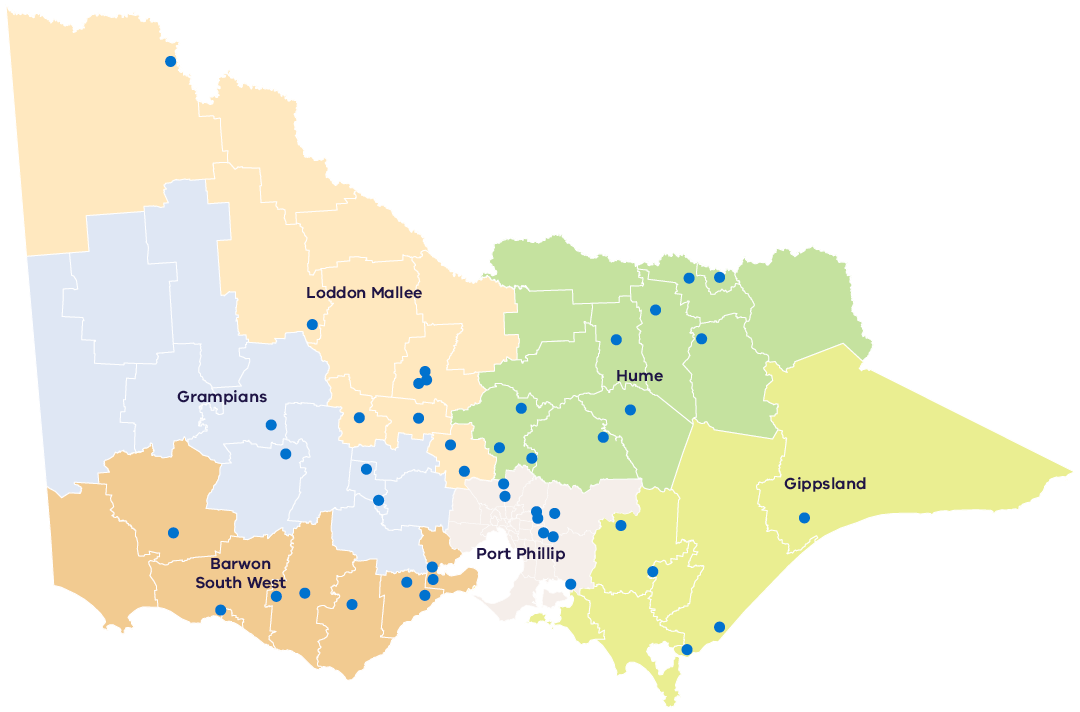Completed April 2019
- Barnawartha
- Camperdown
- Castlemaine
- Eaglehawk
- Gisborne
- Kilmore South
- Kinglake
- Maryborough
- Myrtleford
- Rubicon
- Wangaratta
- Winchelsea
- Woodend
- Woori Yallock
Victoria’s high voltage powerline network has been upgraded in hazardous bushfire risk environments. Safety devices installed across rural and regional areas of Victoria reduce bushfire ignition risks from powerlines. Devices include automatic circuit reclosers and rapid earth fault current limiters.
Automatic circuit reclosers (ACRs) are next generation network protection devices. They immediately detect and turn off power at a fault on high fire-risk days on 12.7 kilovolt single-wire earth return (SWER) powerlines.
CSIRO estimates ACRs reduce the likelihood of ignition on bare-wire SWER powerlines by nearly half (45.7%) under worst-case, bushfire-risk conditions.
As of February 2020, AusNet Services and Powercor have installed more than 2,100 ACRs across their SWER networks. The entire Victorian SWER network (30,000 kilometres) is now protected with this new-generation technology.
Rapid earth fault current limiters (REFCLs) are a life-saving smart technology that acts as a safety giant switch when powerlines come into contact with vegetation. This reduces the risk of bushfires igniting and keeps communities safe. This technology reduces the risk of bushfires starting from powerlines across more than 31,000 km or half the network in Victoria.
REFCLs rapidly limit energy release in certain types of powerline faults on multi-wire (not SWER) power lines. They stop energy flow to the affected powerline almost instantly when a fault occurs.
REFCLs allow the electricity distribution system to continue operating for a short time. This is unlike standard powerline technology, which cuts power off altogether when a fault is detected. REFCLs avoid unnecessary downstream power outages if the fault is temporary. If the fault persists, the REFCL then shuts down the power to the affected powerline.
Trials were conducted in Victoria in 2014–15. They proved REFCLs are 10 times more effective in reducing bushfire risk than existing best practice safety infrastructure.
During Total Fire Ban and Catastrophic fire danger rating days, REFCLs operate at greater sensitivity and may shut down a section of the network where a fault occurs. This reduces the risk of a fault starting a fire on these days. This may mean customers are more likely to experience outages on Total Fire Ban and Catastrophic fire danger rating days.
The rollout of REFCLs has been successfully protecting Victorians from potential bushfires sparked by powerlines since the first installation in 2017. As of 1 November 2023, 45 mandated zone substations have been assessed as compliant by Energy Safe Victoria, the state’s energy regulator.
REFCLs are delivering a safer energy network for all Victorians through:

Rigorous tests on a real electricity distribution network demonstrate that REFCL technology reduces the fire risk associated with bare-wire overhead powerlines.
When a live high voltage conductor falls to the ground under worst-case fire weather conditions such as those experienced on Black Saturday 2009, a REFCL can reduce the conductor-soil arcing in many circumstances to levels below that required to start a fire.
Earth fault on typical Neutral Earth Resister
This filmed test of a powerline falling to the ground simulates the fire start potential of networks under non-REFCL protection systems.
Protected network: 18A fault current into soil, rising to 24A over 0.9s.
Earth fault on REFCL
This filmed test shows that REFCL technology reduces the powerline arcing from a fallen conductor, dramatically reducing the risk of fires associated with bare-wire 22kV overhead powerlines.
The test was performed under worst case fire weather conditions, such as those experienced on Black Saturday 2009.
Protected network: fault current into soil 15A peak falling to zero in 55ms, no current on second bounce or beyond.
Page last updated: 03/11/23